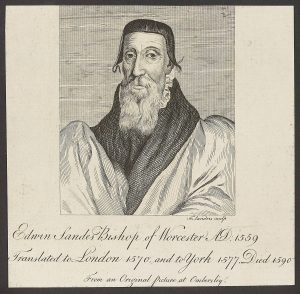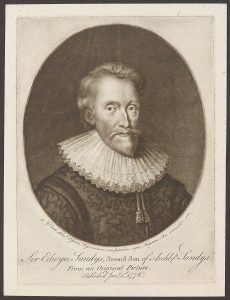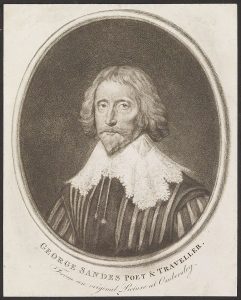Introducing the Sandys Family of Ombersley, Part One
- 18th November 2024
This blog contains a reference to slavery.
The complex lineage of the Sandys family begins with Edwin Sandys born in 1518. A Protestant Cleric to King Edward VI, he later fled the country to avoid a sentence of death upon the Catholic Queen Mary’s accession to the throne. Under Elizabeth I, he served as Bishop of Worcester (where he resided at Hartlebury Castle), Bishop of London and later as Archbishop of York. Edwin and his wife Cecilia (nee Wilford) (1537-1611) had eight children. It was their eldest son Samuel (1560-1623) – the first of many – who, according to record, bought Ombersley Court in 1614 by deed of perpetuity from the Crown (although another source claims Edwin purchased it a quarter of a century earlier and then left it to his son by will).

Copy of an engraving of Edwin Sandys, c.1750 – Reference: 899:156 WPS8220
Sir Samuel was an MP for Worcestershire and became High Sheriff of the county in 1619. His brother, another Edwin (1561-1629), was also an MP and a ‘colonial entrepreneur’ who joined the Council of the Virginia Company soon after it was founded. Edwin later became its first non-merchant Treasurer, and it was in this role that he received a letter from the colonist John Rolfe – an early settler in the English colony established by the Company and most famously Pocahontas’ husband – confirming the delivery of ‘not anything but 20 and odd Negroes, which the governor and cape merchant bought for victuals’. Edwin’s youngest brother George Sandys (1578-1644), a reputed poet and prose writer, was also associated with the Virginia Company, spending three years in the colony as an agent there.
Sir Samuel married Mercy Culpepper (1564-1630) and their son Edwin (1591-1623) served twice in his short life as a member of parliament, first for Droitwich and then for Pontefract. He married Penelope Bulkeley (1586-1680) in 1614, and they had four children. Their eldest surviving son was Colonel Samuel Sandys MP for Droitwich and Worcestershire (1615-1685), and it is he who played a prominent role in the English Civil War. An eminent supporter of Kings Charles I and II, he fought in battles, commanded the garrison of Worcester and mustered Royalist regiments to fight in defence of the Crown. We hold in our archive personal letters sent to this ‘Sam Sandys’ from the martyred Charles I, which tell us they were close friends. The Civil War also saw members of the Sandys family fight in opposition to one and other. Colonel Sam and his brothers Martin and Henry Sandys were Cavalier officers on the side of the Royalists, whilst their cousin Edwin (1612–1642) led the Parliamentarians in the Battle of Powick.

Copy of an engraving of Sir Edwin Sandys, 1776 – Reference: 899:156
WPS14087

Copy of an engraving of George Sandys, c.1650 – Reference: 899:156 WPS8350
Colonel Sam was married twice. First to Mary Barker (d.1651) in 1636. Their son, another Samuel (c.1640-1701), became the third Sandys to stand as a MP for Droitwich – perhaps unsurprisingly since it was the town closest to Ombersley. Although he held this seat for nearly thirty years, Samuel made little of a mark. In 1655, Samuel married Elizabeth Pettus (1640-1714), the heiress of Sir John Pettus, and their son, a fourth Edwin (1659-1699) and again an MP, represented Worcestershire following his father’s retirement. When this Edwin died prematurely aged forty, he left as his heir his four-year old son, yet another Samuel Sandys (1695-1770), who became the 1st Baron Sandys of Ombersley.
Born in Greenwich on 10th August 1695, this Samuel and his two siblings were raised predominantly by their grandmother Elizabeth – their only close surviving relative following the premature death of their parents in 1699 and 1701. Samuel was ambitious in politics. In 1718, and in the family tradition, he was elected to parliament for the Worcester constituency as a member of the political Whig party. He held this seat for twenty-five years before becoming Chancellor of the Exchequer. This, after years spent in opposition battling with the man considered Britain’s first Prime Minister, Robert Walpole. Samuel bore much criticism as Chancellor and left the post after only twenty-two months, though he continued to play a role in politics over a further three decades, as a member of the House of Lords. Samuel’s uncles – Martin Sandys (1672-1753) who was Town Clerk of Worcester, and Sir John Rushout (1685 –1775) a Whig MP for Malmsebury – were his close political allies.
In 1725, Samuel married Letitia Tipping (1699-1779) – a fortunate heiress who inherited the estate of her great-uncle Admiral Edward Russell, Earl of Oxford and an important figure in the Glorious Revolution of 1688. He and Letitia resided primarily in London, whilst their children lived at Ombersley Court with nursemaids and nannies. It was at this house in Upper Grosvenor Street that Samuel died, after succumbing to bruises he sustained when his carriage was overturned on his return to town from Hertfordshire. Of Samuel and Letitia’s ten children, seven of whom sadly died during their lifetimes, Edwin 2nd Baron Sandys (1726-1797) was their only son to survive his father.
A leading scholar and avid collector of books, Edwin excelled academically and was a lifelong friend to prominent Worcestershire historian The Reverend Doctor Treadway Russell Nash. Aged twenty-one, he too became an MP for Droitwich, but by the next election in 1754 he was out. He was briefly appointed to office in April 1757 but resigned three months later. He was then returned to parliament as an MP for Westminster. Although Edwin sat in the House of Commons for twenty-three years, he is said to have never once spoken; though he was a present member who sat on committees and engaged with requests from his home county. As one of the vice-presidents of the Westminster Infirmary he was elected a Trustee of the British Museum in 1769.
Edwin married later in life to Anna Maria King (nee Colbrook) (1720-1806) but they had no children. It was therefore Edwin’s niece, Mary – daughter of his brother Colonel Martin Sandys (1729-1768) – who came to inherit Ombersley Court and the Sandys line in 1806.
We’ll look at the fascinating life of Mary Marchioness of Downshire and Baroness Sandys (1764-1836), and those of her successors, in Part Two.
If you would like to access any of the records mentioned in this blog, please submit an enquiry at ArchiveEnquiry (worcestershire.gov.uk) or speak to a member of archive staff on Level 2 of The Hive.
Post a Comment